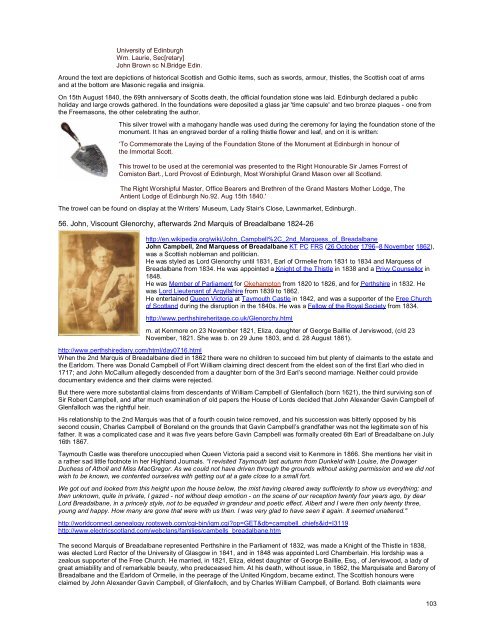Grand Masters of Scotland - Onondaga and Oswego Masonic ...
Grand Masters of Scotland - Onondaga and Oswego Masonic ...
Grand Masters of Scotland - Onondaga and Oswego Masonic ...
Create successful ePaper yourself
Turn your PDF publications into a flip-book with our unique Google optimized e-Paper software.
University <strong>of</strong> Edinburgh<br />
Wm. Laurie, Sec[retary]<br />
John Brown sc N.Bridge Edin.<br />
Around the text are depictions <strong>of</strong> historical Scottish <strong>and</strong> Gothic items, such as swords, armour, thistles, the Scottish coat <strong>of</strong> arms<br />
<strong>and</strong> at the bottom are <strong>Masonic</strong> regalia <strong>and</strong> insignia.<br />
On 15th August 1840, the 69th anniversary <strong>of</strong> Scotts death, the <strong>of</strong>ficial foundation stone was laid. Edinburgh declared a public<br />
holiday <strong>and</strong> large crowds gathered. In the foundations were deposited a glass jar 'time capsule' <strong>and</strong> two bronze plaques - one from<br />
the Freemasons, the other celebrating the author.<br />
This silver trowel with a mahogany h<strong>and</strong>le was used during the ceremony for laying the foundation stone <strong>of</strong> the<br />
monument. It has an engraved border <strong>of</strong> a rolling thistle flower <strong>and</strong> leaf, <strong>and</strong> on it is written:<br />
‘To Commemorate the Laying <strong>of</strong> the Foundation Stone <strong>of</strong> the Monument at Edinburgh in honour <strong>of</strong><br />
the Immortal Scott.<br />
This trowel to be used at the ceremonial was presented to the Right Honourable Sir James Forrest <strong>of</strong><br />
Comiston Bart., Lord Provost <strong>of</strong> Edinburgh, Most Worshipful <strong>Gr<strong>and</strong></strong> Mason over all <strong>Scotl<strong>and</strong></strong>.<br />
The Right Worshipful Master, Office Bearers <strong>and</strong> Brethren <strong>of</strong> the <strong>Gr<strong>and</strong></strong> <strong>Masters</strong> Mother Lodge, The<br />
Antient Lodge <strong>of</strong> Edinburgh No.92. Aug 15th 1840.'<br />
The trowel can be found on display at the Writers’ Museum, Lady Stair’s Close, Lawnmarket, Edinburgh.<br />
56. John, Viscount Glenorchy, afterwards 2nd Marquis <strong>of</strong> Breadalbane 1824-26<br />
http://en.wikipedia.org/wiki/John_Campbell%2C_2nd_Marquess_<strong>of</strong>_Breadalbane<br />
John Campbell, 2nd Marquess <strong>of</strong> Breadalbane KT PC FRS (26 October 1796–8 November 1862),<br />
was a Scottish nobleman <strong>and</strong> politician.<br />
He was styled as Lord Glenorchy until 1831, Earl <strong>of</strong> Ormelie from 1831 to 1834 <strong>and</strong> Marquess <strong>of</strong><br />
Breadalbane from 1834. He was appointed a Knight <strong>of</strong> the Thistle in 1838 <strong>and</strong> a Privy Counsellor in<br />
1848.<br />
He was Member <strong>of</strong> Parliament for Okehampton from 1820 to 1826, <strong>and</strong> for Perthshire in 1832. He<br />
was Lord Lieutenant <strong>of</strong> Argyllshire from 1839 to 1862.<br />
He entertained Queen Victoria at Taymouth Castle in 1842, <strong>and</strong> was a supporter <strong>of</strong> the Free Church<br />
<strong>of</strong> <strong>Scotl<strong>and</strong></strong> during the disruption in the 1840s. He was a Fellow <strong>of</strong> the Royal Society from 1834.<br />
http://www.perthshireheritage.co.uk/Glenorchy.html<br />
m. at Kenmore on 23 November 1821, Eliza, daughter <strong>of</strong> George Baillie <strong>of</strong> Jerviswood, (c/d 23<br />
November, 1821. She was b. on 29 June 1803, <strong>and</strong> d. 28 August 1861).<br />
http://www.perthshirediary.com/html/day0716.html<br />
When the 2nd Marquis <strong>of</strong> Breadalbane died in 1862 there were no children to succeed him but plenty <strong>of</strong> claimants to the estate <strong>and</strong><br />
the Earldom. There was Donald Campbell <strong>of</strong> Fort William claiming direct descent from the eldest son <strong>of</strong> the first Earl who died in<br />
1717; <strong>and</strong> John McCallum allegedly descended from a daughter born <strong>of</strong> the 3rd Earl’s second marriage. Neither could provide<br />
documentary evidence <strong>and</strong> their claims were rejected.<br />
But there were more substantial claims from descendants <strong>of</strong> William Campbell <strong>of</strong> Glenfalloch (born 1621), the third surviving son <strong>of</strong><br />
Sir Robert Campbell, <strong>and</strong> after much examination <strong>of</strong> old papers the House <strong>of</strong> Lords decided that John Alex<strong>and</strong>er Gavin Campbell <strong>of</strong><br />
Glenfalloch was the rightful heir.<br />
His relationship to the 2nd Marquis was that <strong>of</strong> a fourth cousin twice removed, <strong>and</strong> his succession was bitterly opposed by his<br />
second cousin, Charles Campbell <strong>of</strong> Borel<strong>and</strong> on the grounds that Gavin Campbell’s gr<strong>and</strong>father was not the legitimate son <strong>of</strong> his<br />
father. It was a complicated case <strong>and</strong> it was five years before Gavin Campbell was formally created 6th Earl <strong>of</strong> Breadalbane on July<br />
16th 1867.<br />
Taymouth Castle was therefore unoccupied when Queen Victoria paid a second visit to Kenmore in 1866. She mentions her visit in<br />
a rather sad little footnote in her Highl<strong>and</strong> Journals. I revisited Taymouth last autumn from Dunkeld with Louise, the Dowager<br />
Duchess <strong>of</strong> Atholl <strong>and</strong> Miss MacGregor. As we could not have driven through the grounds without asking permission <strong>and</strong> we did not<br />
wish to be known, we contented ourselves with getting out at a gate close to a small fort.<br />
We got out <strong>and</strong> looked from this height upon the house below, the mist having cleared away sufficiently to show us everything; <strong>and</strong><br />
then unknown, quite in private, I gazed - not without deep emotion - on the scene <strong>of</strong> our reception twenty four years ago, by dear<br />
Lord Breadalbane, in a princely style, not to be equalled in gr<strong>and</strong>eur <strong>and</strong> poetic effect. Albert <strong>and</strong> I were then only twenty three,<br />
young <strong>and</strong> happy. How many are gone that were with us then. I was very glad to have seen it again. It seemed unaltered."<br />
http://worldconnect.genealogy.rootsweb.com/cgi-bin/igm.cgi?op=GET&db=campbell_chiefs&id=I3119<br />
http://www.electricscotl<strong>and</strong>.com/webclans/families/cambells_breadalbane.htm<br />
The second Marquis <strong>of</strong> Breadalbane represented Perthshire in the Parliament <strong>of</strong> 1832, was made a Knight <strong>of</strong> the Thistle in 1838,<br />
was elected Lord Rector <strong>of</strong> the University <strong>of</strong> Glasgow in 1841, <strong>and</strong> in 1848 was appointed Lord Chamberlain. His lordship was a<br />
zealous supporter <strong>of</strong> the Free Church. He married, in 1821, Eliza, eldest daughter <strong>of</strong> George Baillie, Esq., <strong>of</strong> Jerviswood, a lady <strong>of</strong><br />
great amiability <strong>and</strong> <strong>of</strong> remarkable beauty, who predeceased him. At his death, without issue, in 1862, the Marquisate <strong>and</strong> Barony <strong>of</strong><br />
Breadalbane <strong>and</strong> the Earldom <strong>of</strong> Ormelie, in the peerage <strong>of</strong> the United Kingdom, became extinct. The Scottish honours were<br />
claimed by John Alex<strong>and</strong>er Gavin Campbell, <strong>of</strong> Glenfalloch, <strong>and</strong> by Charles William Campbell, <strong>of</strong> Borl<strong>and</strong>. Both claimants were<br />
103







![Richard [Nicholls] Harison / Harrison - Onondaga and Oswego ...](https://img.yumpu.com/24950065/1/190x245/richard-nicholls-harison-harrison-onondaga-and-oswego-.jpg?quality=85)

![Richard [Nicholls] Harison / Harrison - Onondaga and Oswego ...](https://img.yumpu.com/24950063/1/190x245/richard-nicholls-harison-harrison-onondaga-and-oswego-.jpg?quality=85)







